https://www.youtube.com/watch?v=ZjxYuTRG4RE
7 Most Successful Gambits
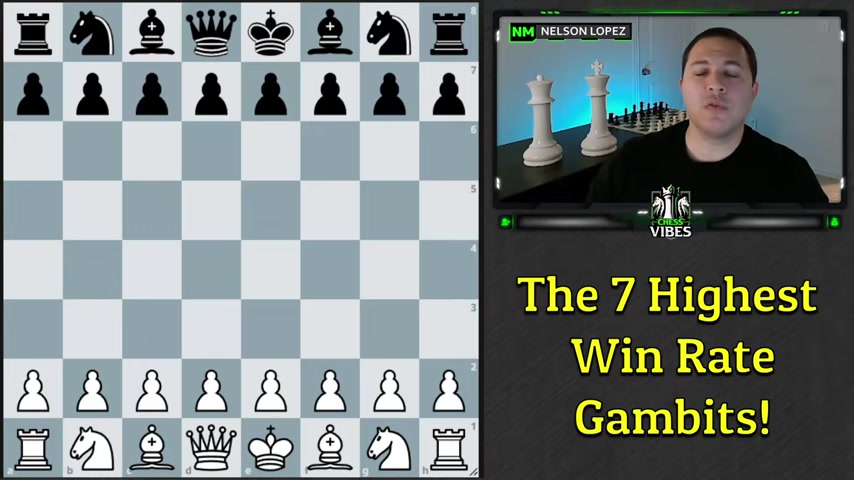
To prepare for this video , I analyzed over 500 gambits and recorded the win rate for each one of them into a spreadsheet .
I then sorted it so I could see the most successful gambits .
Then I went through and filtered out all the ones that are kind of random and obscure that you never actually see in normal chess .
And I was left with a list of the most successful gambits that actually show up in normal opening .
So things like kings gambit , Carol Kahn Alek , he's offense and so on .
So each of these games has over a 60% win rate and my favorite which I'll show you at the end has over an 80% win rate when you get a chance to play it .
Now , before we get into the video , I just want to say a quick thank you to all my new patrons .
We've got Arthur Y , Richard Russell , Sammy Richard C Joey win and two moons .
Thank you guys so much .
I really do appreciate the support as a reminder to everyone .
I do have an upcoming tournament .
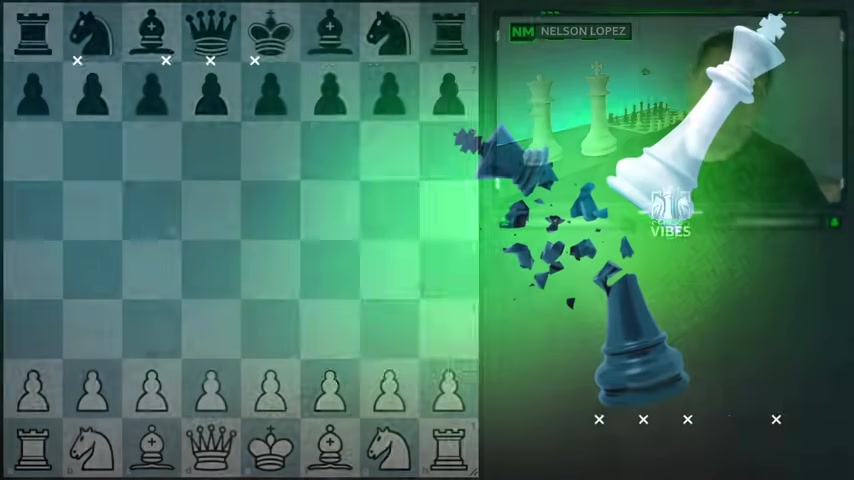
It's my first over the board tournament in like over seven years and it's going to be over Thanksgiving and uh the Patreon members are going to have early access to all those tournament game recaps .
And I've actually been training quite a bit .
So you might , uh you might see me pull out some nice wins or maybe I'll just lose every game .
And that would be sad .
But uh anyway , if you're interested in checking that out , the link is in the description below , but now let's jump right into the video , right ?
So our first gambit is with the black pieces and it comes out of the elephant gambit .
It's actually uh a specific variation of the elephant gambit .
So the elephant gambit if you're not familiar is after a night of three , you play the move D five and white actually can capture either way .
But when they take with the night , you're gonna recapture with the pawn .
And now most players in this position will play bishop C four because they want to go for this week F seven square .
And when they do that , you can now play the wasp variation of the elephant Cabbit .
This is the line that I'm recommending .
And you can see over here black has a 61% win rate when playing this gambit .

I've actually already done a video on this .
Some of you have probably already seen that I'll put a link above my head somewhere if you want to check that out where I go in , in depth uh in all of these lines are relatively in depth .
It's not like an hour long video but , but just real briefly , the main point is that you're letting them capture here on F seven , forking these pieces because you're gonna capture on G two creating your own attack on the rook .
And if white kind of ignores that and just takes your rook , well , then you're gonna capture here and white's in big trouble .
For example , if they play the king up , well , then they can say goodbye to the queen .
They're actually getting mated in a few moves .
And the only other thing they could do in that position would be to block with the bishop .
And you can actually just play the move night F six .
And you've got this threat , you've got this threat and this is completely crushing for Black .
You can see it's only been played eight times but 88% of the time black wins .
So uh that's really good for you .
And then going back here , if they don't take your rook and they just slide the rook over .
We also have a nice little move bishop to G four .
You can see the queen is basically trapped .
Only move for White to do is block with the bishop .
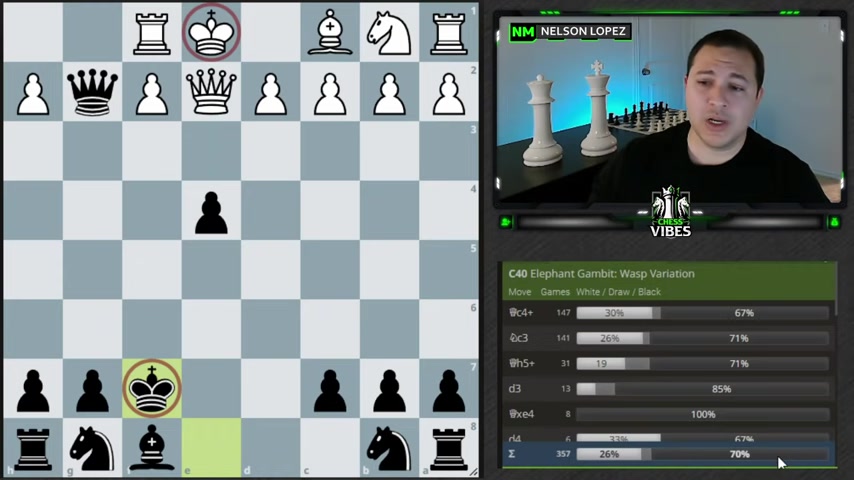
And you can just simply take , take and then you take this night because there's no more bishop defending it .
And you have three pieces .
White only has two pieces you up a piece .
Of course , your king is a little bit exposed , but white's king really isn't that safe either .
And you can see down here 70% of the time this position is reached .
Uh Black wins the game .
So uh that is the wasp variation of the elephant gambit , right ?
The next gambit I wanna show you is with white and it comes out of the king's gambit .
So we're gonna start with E four , E five and then we play F four , which is the king's gambit .
Now , the most common way for black to respond to the king's gambit is actually to accept it and take the pawn .
And then the main line would be night F three and then G five .
So black is defending the pawn , but more importantly than just defending the pond , they're setting up to go here and counterattack your night .
And there's a couple of ways you could play , you could play H four .
You play bishop C four , bishop C four is the most common .
That's what we're gonna look at here .
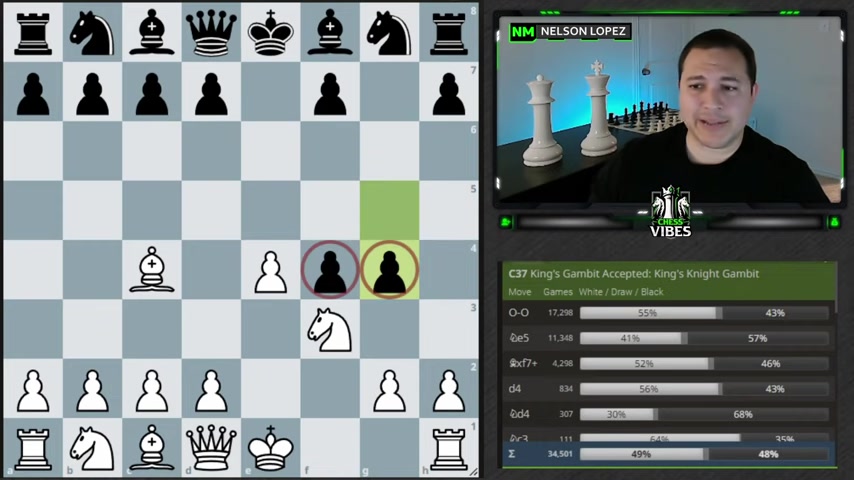
And now black's most common move is to play G four and go ahead and , and kick your night away because the queen's kind of controlling these squares and it looks like black is actually doing OK here with these ponds .
And now what you can do is just castle completely ignore the night .
This is called the Muzo gambit .
And so you're just giving up a piece to basically get your king safer and also get this Rick involved in the game uh as well .
So blacks gonna capture you can retake and now the most common move for black .
And this is actually what the engine recommends is to play queen to F six .
And the queen is kind of coming over here to help sort of defend .
You know , some of these weaknesses that black has and what you can do now is play the move E five and you're trying to just kind of kick this queen away , even though the pawns undefended .
You don't really care about that .
You actually like if black takes it and that's what uh black does and now we can play what's called the double Muzo gambit .
Bishop takes F seven checks .
You're sacrificing a second piece .
King takes F seven and now is where you can go .
Even here .

You can see white does pretty well 57% .
But if you play the Triple Muzzio gambit , uh which is D four check queen takes and then you play bishops E three .
So you're sacrificing a third piece .
Hence Triple Muzzio Gambit .
Now , I don't know why , you know over here on leeches , they don't say triple Muzzio , it just keeps saying double .
But as far as I know this is called triple Muzzio Gambit because you're actually giving up three pieces .
Now , I say you're giving up three pieces , you're not really giving up three pieces because if black tries to take this piece , well , you just take the queen because the pos pinned , right ?
So you don't really have to worry about losing that bishop even though it is called the triple Muzzio gambit .
Um So really what black has to do is move the , the queen .
Now the best move is queen the G7 according to the engine , I don't think anyone's actually gonna play that in a game most likely .
I mean , it's been played a few times but very unintuitive move , you know , putting the queen there allowing you to capture either way here .
Most people don't do that .
Most people go to F six .

And if they go to F six , the , I think the best way to play is just to play NC three getting ready to bring your knight in somewhere .
And so , for example , if they play C six , they kind of take away that square .
Well , then you've got N ce four backing the queen and there's really not anywhere good for the queen to go .
If it tries to stay on this file to block off these pieces , you've got this nasty fork and black can resign now .
And if it does something else like let's just say queen age six , maybe to try to continue to hold on here .
You can just take with the bishop , uh you're attacking the queen and after black moves , I don't know , let's say queen G six like just look at this position for a minute , guys , 123456 .
The only piece is that black has moved being a queen .
And look at this , we've got our queen and rook lined up .
We've got a bishop , we've got a knight .
It , the game is over .
Stockfish says plus 12 and it's still evaluating it might be higher , but basically white is just winning .
So , um this is a really nice gambit that you can play the do the triple Muzio gambit .
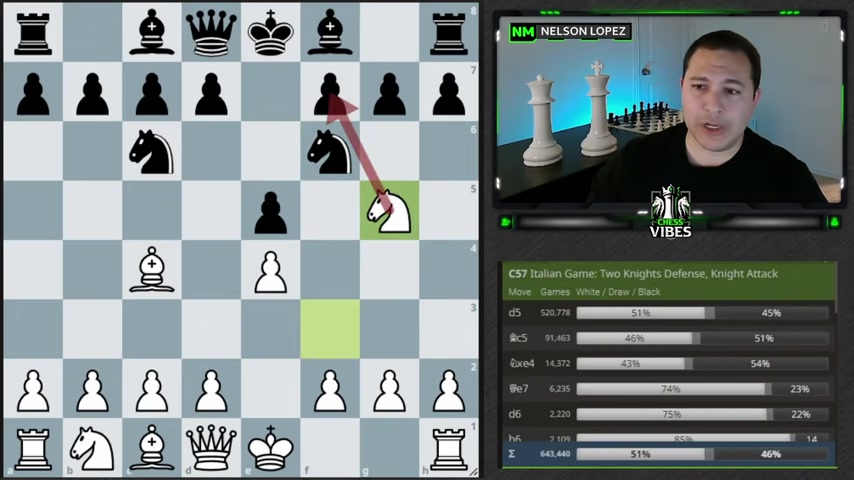
And uh if you get a chance to do this , you can see fantastic win rates for White , right ?
The next game that I'm gonna show you , I'm gonna go ahead and go out on a limb and say most of you are probably familiar with this , but if you're not , here you go .
So it's actually the fried liver attack .
So E four E 59 , F 39 C six Bishops .
We have the Italian game .
Black has two major ways to respond .
Bishop C five and night of six , night of six is the two nights defense and normally when they play two nights defense , night G five is a very good way to go .
You're lining up on F seven and most people will play D five to stop the bishop , you can capture it and a lot of people will play 95 because they want to avoid the fried liver .
But if they take with the night you're in business and now you sacrifice the night on F seven with a fork .
The black basically has to capture and now you can play queen every check , forking these guys .
And so unless black wants to lose the night , they have to play king to E six .
And basically for one piece , you get black to king on E six .
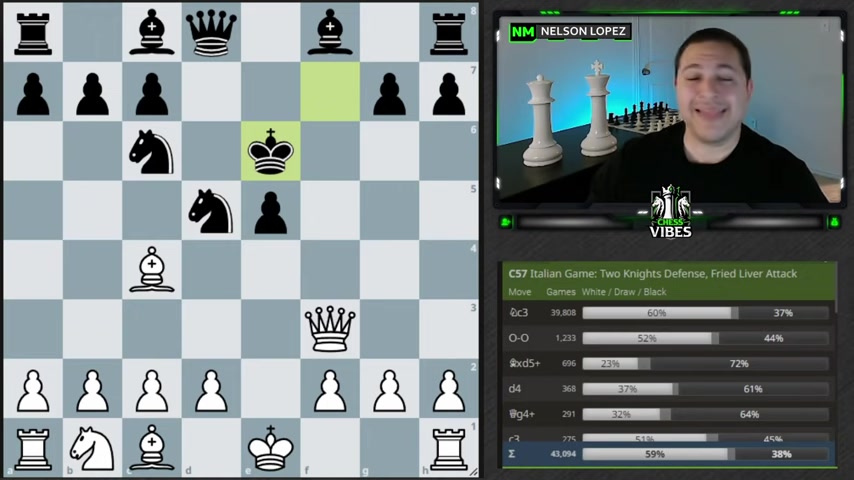
Relatively undefended .
You can castle , you can play nine C three to pile up .
You can play D four to try to open up this file and get your bishop out .
Lots and lots of fun for white .
It's very tough to play for black .
That being said , I did do a video in the past on this channel .
You may have seen it where I said , hey , you can actually play this for back and survive .
Uh with really good play , you can survive .
But um you know , practically speaking , uh you know , you can see here 59% white does really , really well .
So , uh anyway , fried liver attack solid option .
All right .
The next game that we're gonna look at is with black and it also comes out of the king's gambit .
So here we go .
King's Gambit except now from black side .
And again , we're gonna look at this King's gambit accepted night of three G five .
So we saw this before except it was from the other side of the board .
Same move here , G four again , same move .
And now you remember white castled and went into the double and eventually triple .
Muzio Gambit .
The other main move that White can do is play Knights E Five .
And that's what we're gonna look at .
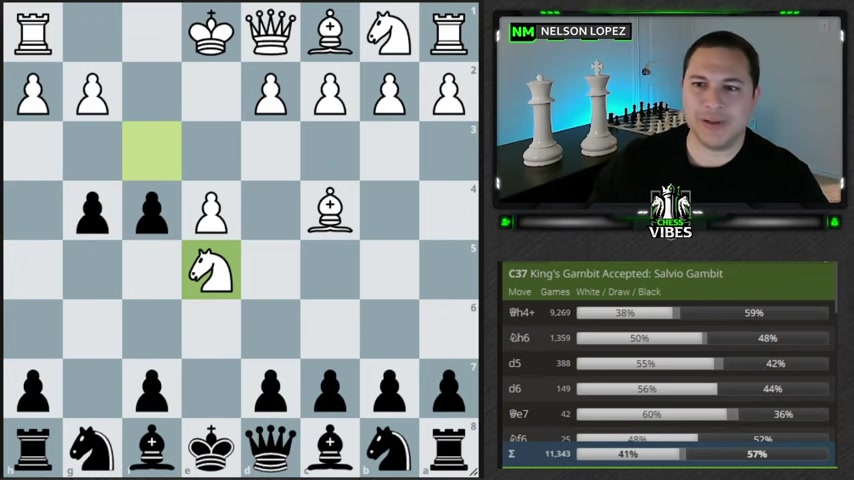
Now , if they play Knights E Five , they're basically setting up this attack .
Now , one of the things about the king's gambit is you have opened up this diagonal from move two and normally the nine NF three does a nice job of preventing the queen from harassing the king .
But now the night has moved .
So what are we gonna do ?
Well , we're gonna take advantage of that and play queen H four check .
We also have the bonus that we've got this pawn here .
But if white tried to block us , well , we could just capture it and they can't really take back or they're um losing the rook , right ?
So White has to find the king over and now we want to deal with this threat .
We're , we're gonna play 986 and then , you know , kind of a natural looking move here for white D three allows us to go into what is called the Silber Schmidt gambit .
I believe I pronounced that right .
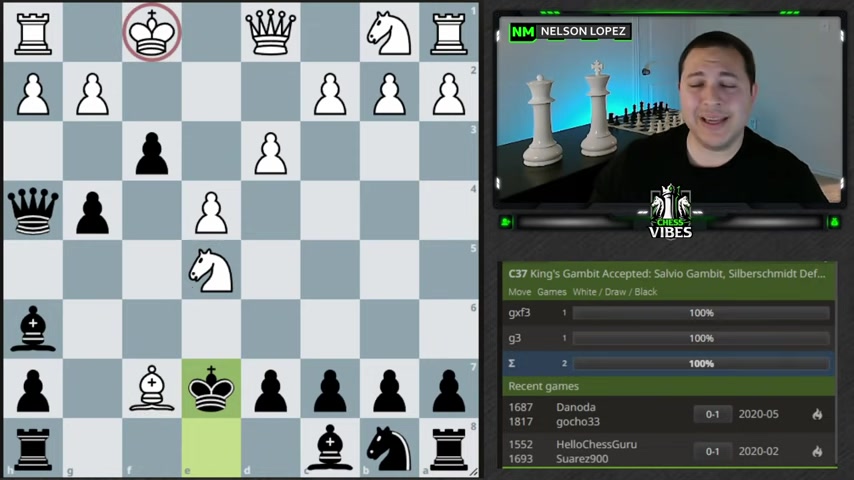
Basically , at this point , uh we play the move F three and it's a little bit counterintuitive because we're opening up the bishop and , you know , basically , once White captures here , which is what they usually play and we take , which is what we're gonna play .
We've allowed them to capture here .
But the thing is this isn't really a big deal anymore because even if they take it , it doesn't really matter how they , let's say they take it with check .
We just slide our king up and like , what , what is , what is White gonna do with these pieces ?
Now , there's just like not even any threats and now all of a sudden it's White's king that's in big trouble .
So for example , after like a natural developing move , what are we gonna do ?
We're gonna take , they're gonna take , we're gonna play queen age three check .
And if they try to go back , the game is over , that's a nice mate .
And so they have to play king to F two .
And what that does is allows us to take advantage of this open file so we could play Rook F eight .
But it's actually better to play D six first .
Take the night away .
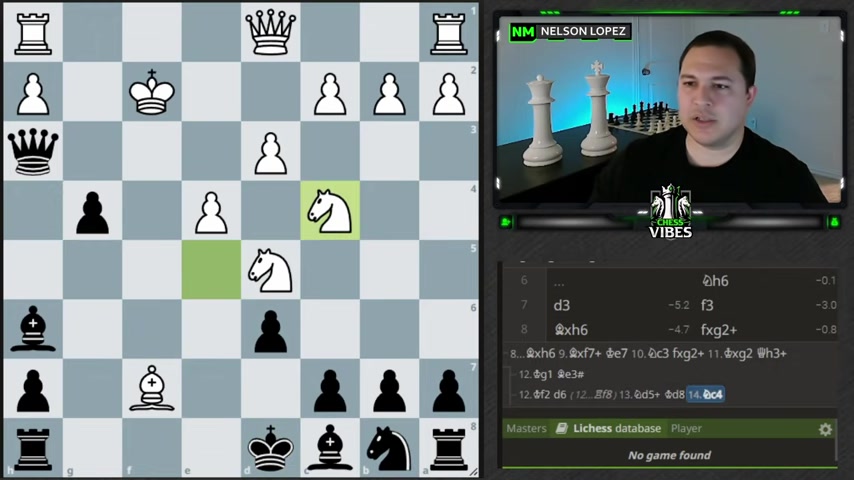
And so for example , uh and by the way , if they play 95 we just bring our king back here , it doesn't really matter .
And then once the night moves , like let's say over to C four , then we bring the rook over lining up and white actually has nothing like no attack .
The queen can't even go anywhere useful .
Our bishop is awesome .
Our queen is awesome .
Our Rick is awesome .
This bishop is good .
So if you ever get a chance to play the Silver Schmidt gambit go for it .
Right .
The next gambit is with white and it comes out of the Alec Kines defense .
So Alec Hes is nine to F six .
And usually the best way to respond to this is just to push forward , get some space kick the night around nine to D five C four .
Pretty common stuff , night to B six .
Now , at this point , a lot of people will just play something like D 49 F three and black plays D six and there should be two .
And , you know , uh you can get a different type of game , but one way to play it is to play C five and attack the night immediately again .
And usually they'll hop back into D five because now your pawns are advanced .
You , you can't um attack it with your pawns anymore .

But what you can do is play nine C three attacking it this way and black could just defend it with one of these moves or they could take it .
This is the second most common move and if they take it , uh you're gonna take with the D pawn .
And at this point , black has two ways to go .
They can play E six or D six .
Most people choose D six because it kind of makes sense to go ahead and start counter , uh attacking these pawns , try to break something open in the center and get , get rid of these annoying pawns .
So the black can actually do something .
And if they play this now is when you can enter into what is called the matsuo vic gambit .
Hopefully , I'm pronouncing that correctly , but you play the move bishop to G five .
And at first glance , it's kind of like what , what , what are we even doing here that we're not attacking the night because there's no night on enough six .
We're not like , really doing much .
I mean , here we're pinning upon , but it's kind of like whatever , you know , here's the deal .
Uh Most common we played DKC five and by the way , check out the win percentage for White on this 1 66% from this position .
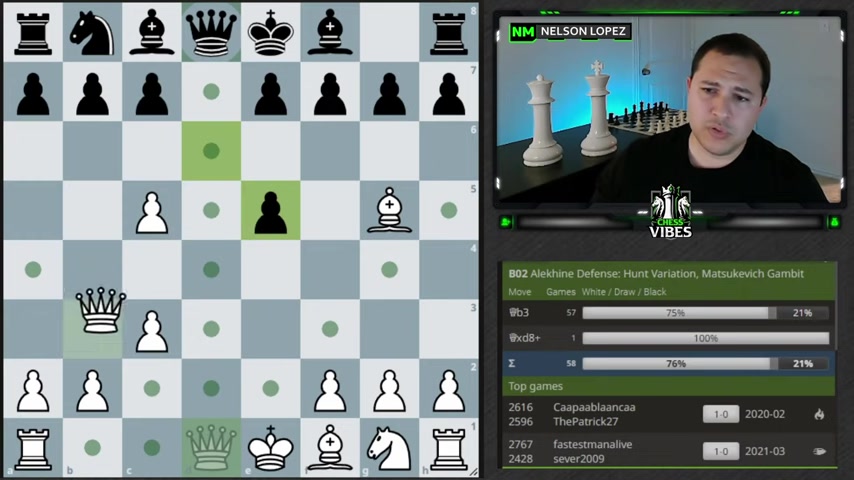
Now , if what black just kind of takes here hoping to maybe just trade and go into some kind of an end game .
We're gonna play the killer move queen to be three .
And at first glance , it's like , ok , like what , what are we actually doing here ?
We got our bishop over here , we got our queen here .
It's kind of hard to see what we're doing until you start to ask yourself the question .
What is black gonna play in this position ?
Like normally , you know , you might think , well , e six is kind of a normal move to let the bishop out .
You can't do that because they , the , the pa is pinned .
Ok ?
Um Well , no , maybe we'll bring this bit up .
No , you can't bring that bishop out because we've got this like , ok , well , if I've got a night , let me develop my knight .
Right .
Let's put the knight on C six .
Guess what game is over now ?
Rook to D eight .
I'm sorry , Rook D one attacking the queen .
And what do you notice about the queen ?
Not a lot of places to go .
Right .
Only thing black could try is bishop D seven .
And that , well , then you have bishop C four and look at this .
That's check me and how are you gonna stop that ?
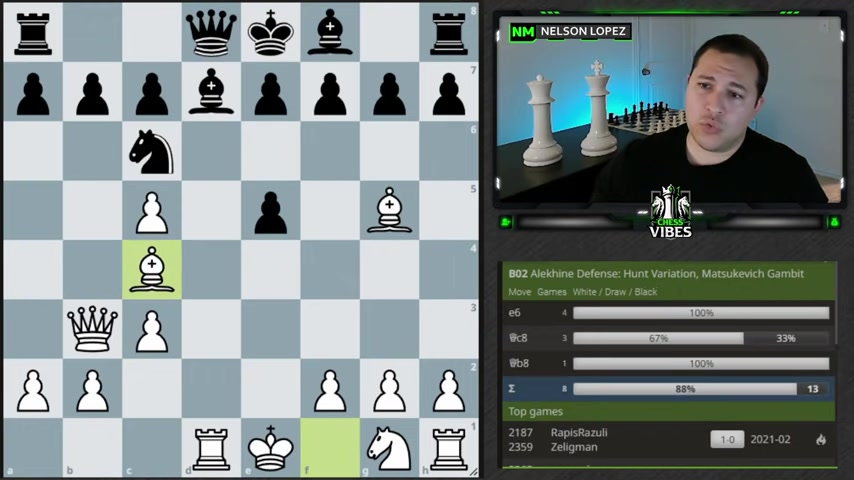
Well , E six is kind of the normal way except , oh , there goes your queen .
So yeah , there's no real way to stop it .
The game is basically over like , I mean , White has like all these threats and Black can't really do anything .
So that's kind of the problem that Black has like it .
There's , there's no moves like let's take this 1 97 again .
Bishop C four .
How do you stop this ?
You have to play E six .
You don't play E six , you're just getting checkmated , but that gives up your queen .
So you see , black has the problem .
There's no move to play and the only move um is queen 87 which is like such a weird looking move , it blocks the bishop .
It's like , what , what are you doing ?
And even this , you know , white , white is fine .
You can just do something like nine of three .
Let's see what is the engine like , yeah , nine of three is fine and uh you're just in a great position .
It's only happened a couple of times but white , you know , won , won this game pretty easily , but it's just really awkward or black .
So anyway , Masuko Gambit bishop to G five , that's kind of the whole idea .
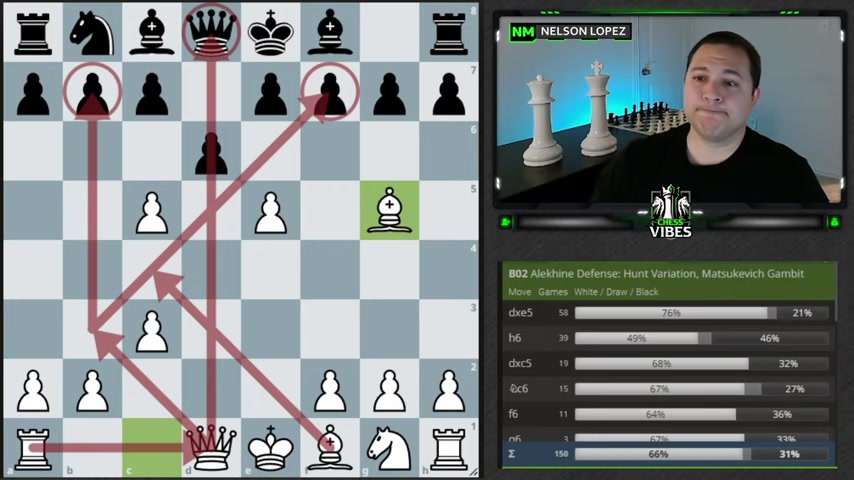
This queen B three bishop C four line up here , put the pressure there , bring the rook over and the queen sometimes gets trapped .
Um Yeah , really , really fun one to play when you get a chance .
So keep that in mind , right ?
The next game that I wanna show you is with white and it comes out of the Vienna game .
So we have E four E five and then night C three .
So this is the Vienna game .
So instead of going with kind of the normal night F three , you play night C three and then on night C six , bishop C four , bishop C five is pretty common .
Although this is already starting to get in trouble for blacks .
Surprisingly as that may be .
So now you play the move queen to G four and you're lining up on this pond .
And by the way , I did a comprehensive video on this , this move here , I'll link it above if you want to watch that or I'll go into a lot more details .
But the idea is that how does black defend this pawn ?
Well , they don't really want to go back where they just came from , uh , you know , something like G six is playable , but this is pretty bad .
You're creating like lots of weaknesses and it's not a move that you really want to play .
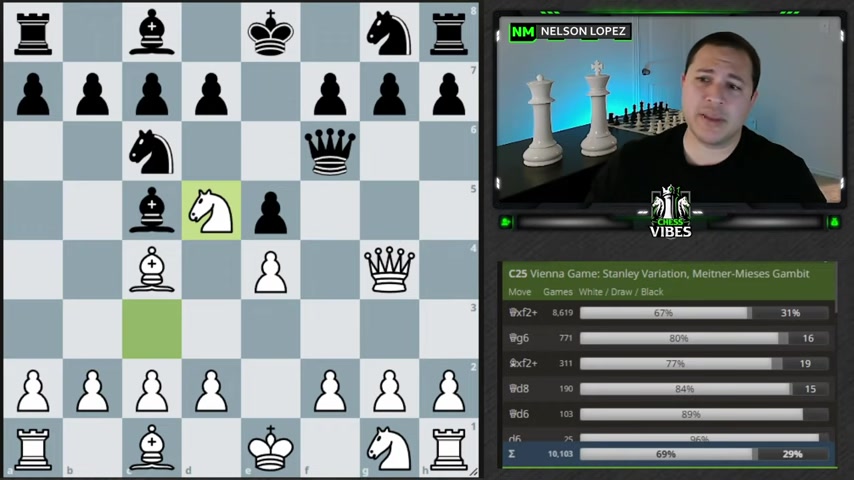
And so most people at this point will just play queen of six because not only are they defending , they're also lining up here , which looks pretty scary .
But , you know , if we're white , oh , that's like almost checkmate , right ?
Well , here's the thing .
You just completely ignore it .
You play the move 90 to D five .
And this is called the uh the me me gambit .
I don't know if I'm pronouncing that .
Right ?
Probably not .
But this is what I talk about in the other video that I , you know , linked to both , but basically you're letting Black really encouraging them to take it with the queen and when they do , they're basically just lost already .
You slide the king over and all of a sudden it becomes clear that how does Black proceed ?
This is defended .
This is defended , this is defended .
Everything is defended .
The queen can't really do anything .
And now we have the , the attack .
If we take here , we're gonna win the rook .
If we take here , we're gonna win this rook .
What is Bob gonna do ?
You know there's lots of moves you can , can look at .
This is an example most commonly moved played is , is D six trying to like bring open the bishop here , but you just take on G7 threatening this .
It does get a little bit tricky .
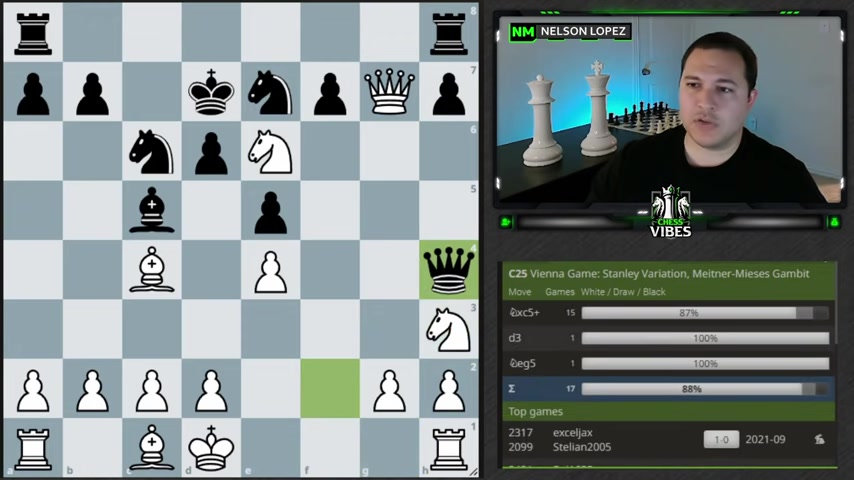
So you probably do want to go watch that other video .
But like one line , for example , here , bishop E six you take here with check , you've got this triple fork .
And the idea is that you actually don't even want the rook .
And the reason you don't want the rook is because now black can take your bishop and that bishop was really important because it was controlling this .
Now , black can come in here and check me you um if you're not careful .
So what you do is you take that bishop with your knight and this pawn is pinned .
OK ?
So it can't take it , the king can't take it because it's defended .
So you just got the bishop for free and you're , you're still in a really good position .
Black doesn't really have any kind of counter play .
Now , they can save the rook now , but it doesn't even matter .
You play night age three , kick the queen away after something like queen H four .
I think you just bring this rook over or , or even queen G five looks even better there .
There's a lot of good moves , but I guess you can take this , you can play queen G five .
Try to trade .
I mean , you're up the piece .
Um This probably looks like the best but yeah , this is really good for white .

Uh You can , you can play around with it if you want or go watch that video , like I said , but going back to the beginning here , you can see once you get this 95 moving in 69% win rate for white .
I mean , it's , it's crazy .
But anyway , make sure you keep this one in mind .
This one is actually much more common .
You can see 10,000 positions have been reached with this one .
And so this is , this is quite common in the Vienna .
All right guys , and I've saved the best for last .
We're gonna be looking at the Leow gambit with an over 80% win rate .
So let's see how this , this thing starts .
E four C six .
OK .
So it's another one against the Carol .
Now , I've actually seen quite a few tricks and traps against the Carol Con and I had not seen this one until I was preparing for this video .
So , uh hopefully you'll find this interesting too , but D four .
OK .
Most common move D five and now there's all sorts of things that white plays here .
Most common is E five .
Then you have E takes D five , you have NC three .
sorry .
Nine C 39 D two F three .
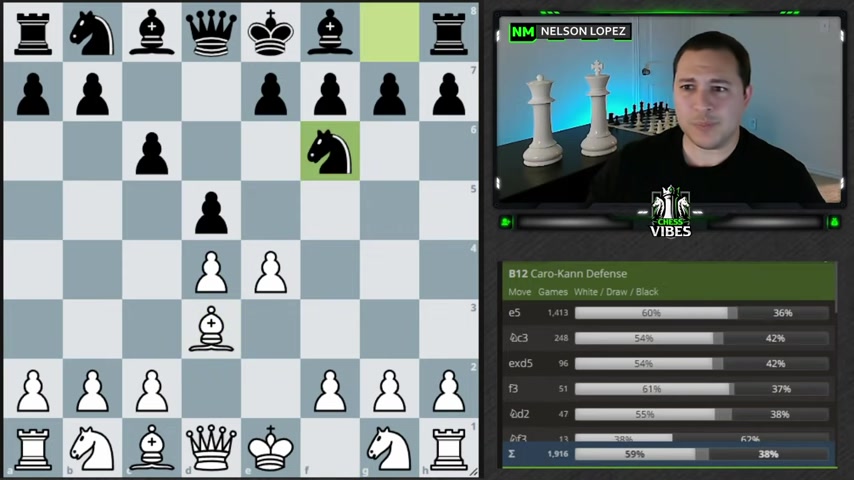
And it's the next move way , way down there that we're gonna play bishop to D three .
OK .
Very uh kind of a weird move most people uh will take it .
And that's unfortunate because then we can't really do our travel .
But second move played from time to time night of six .
And now is when blacks in big trouble , what we're gonna do is push by chasing the night away .
They can't , they can't go here or here because of our queen .
If they try to hop in , well , then we can just play F three and it's trapped .
Ok .
The ponds are controlling all those bishops .
Uh Sorry , I can't control tonight .
Bishops are controlling that .
You just want a piece .
Ok .
So the only thing they can really do is either go back to where they came from , which is probably the best move , surprisingly , uh or what everybody does in this position is to go here .
Now , this is where you get to play the Landau gambit and the move is E six .
And what we are doing is basically saying , well , I'm attacking your night and if you move that , I'm gonna take here with check .
So you probably don't want to let me do that .
But here's the problem .
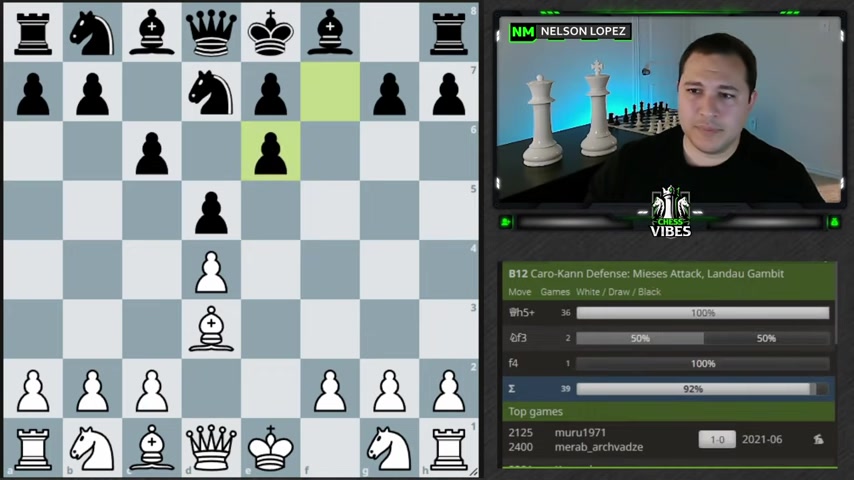
If they take with the pawn , you've got queen H five check .
And what is black gonna do now ?
Well , G six and of course you have to take with the queen , not the bishop , take with the queen first and then you deliver checkmate with the bishop .
So really nasty , smothered , smothered type of mate here .
Uh If they do that .
So the , the only thing they could do is move the night .
Right .
So let's say Night of Six and then you can just take here and look what you've done to Black's King .
No more castling .
It's exposed .
And on top of that , you can play Night of three and you've got all sorts of nice juicy places to go .
And this is just a mess .
I mean , this is just a mess for Black and you can see , look , this 79% win rate .
Go back to this position .
Um , right this position , 83% win rate .
It's nuts .
So unfortunately you don't always get a chance to do it because they , um , they usually will probably take here .
But if they don't and they play night of six , there you go and out camp it .
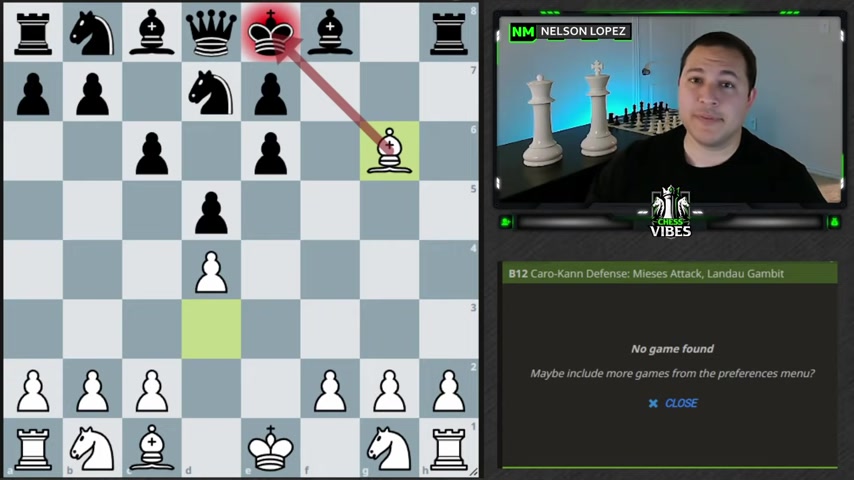
Anyway , guys , I hope you enjoyed this video and maybe learned a thing or two and had some fun .
If you do want to check out the other video I mentioned where I go in more depth into that one line that we looked at .
It's right over here .
Check that out right over right over here .
Here here .
Harder to do than you would think .
Anyway , stay sharp , stay smart , take care .
Are you looking for a way to reach a wider audience and get more views on your videos?
Our innovative video to text transcribing service can help you do just that.
We provide accurate transcriptions of your videos along with visual content that will help you attract new viewers and keep them engaged. Plus, our data analytics and ad campaign tools can help you monetize your content and maximize your revenue.
Let's partner up and take your video content to the next level!
Contact us today to learn more.